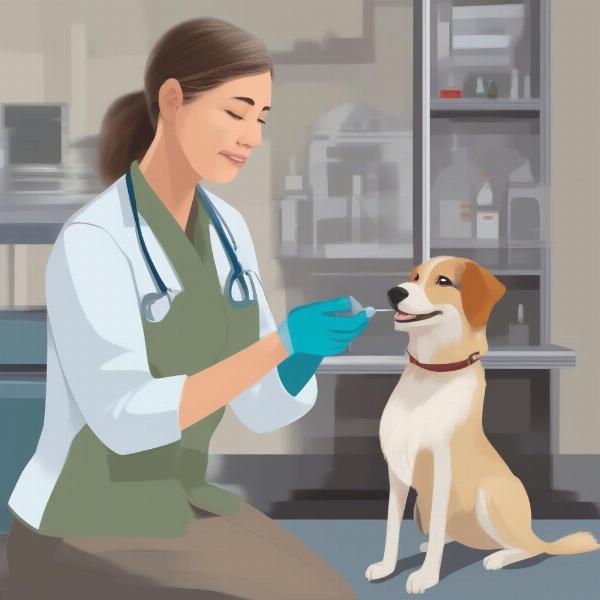The search term “mad dog 50 50” often reflects a fear of rabies and a misunderstanding of its transmission. While the phrase might suggest a 50/50 chance of contracting rabies from a dog bite, this isn’t accurate. This article aims to clarify the realities of rabies transmission, debunk the “50/50” myth, and provide practical advice for dog owners and anyone concerned about rabies. We’ll explore rabies prevention, responsible dog ownership, and steps to take if you encounter a potentially rabid animal.
Rabies is a serious viral disease that affects the central nervous system. While it can be fatal, it’s also preventable. The “mad dog 50 50” misconception likely stems from the historical lack of readily available post-exposure prophylaxis (PEP). Today, PEP is highly effective in preventing rabies if administered promptly after a potential exposure. The actual risk of contracting rabies from a dog bite varies depending on several factors, including the dog’s vaccination status, the geographic location, and whether the bite was provoked.
Rabies Transmission and Prevention
Rabies is primarily transmitted through the saliva of an infected animal, usually through a bite. The virus travels from the bite site to the brain, where it causes inflammation and ultimately death if left untreated. Vaccination is the cornerstone of rabies prevention in both humans and animals.
Vaccinating your dog against rabies not only protects your pet but also significantly reduces the risk of human exposure. Regular booster shots are essential to maintain immunity. Responsible dog ownership also involves preventing your dog from roaming freely, as this can increase the risk of encounters with wildlife that may carry rabies.
What to Do if You’re Bitten by a Dog
If you’re bitten by a dog, it’s crucial to take immediate action, even if the dog appears healthy. Wash the wound thoroughly with soap and water for at least 15 minutes. Contact your doctor or local health department immediately. They can assess the risk of rabies exposure and determine if PEP is necessary. If possible, try to identify the dog and its owner to determine its vaccination status.
Recognizing Signs of Rabies in Dogs
While not all aggressive dogs have rabies, certain behavioral changes can indicate potential infection. These include excessive drooling, difficulty swallowing, staggering gait, paralysis, and unprovoked aggression. If you observe these signs in a dog, avoid approaching it and contact animal control immediately.
Is the “Mad Dog 50 50” Myth Dangerous?
Yes, the “mad dog 50 50” myth can be dangerous because it can lead to complacency. People might underestimate the seriousness of rabies or delay seeking medical attention after a potential exposure. Understanding the facts about rabies transmission and prevention is crucial for protecting yourself and your community.
 Rabies Prevention through Dog Vaccination
Rabies Prevention through Dog Vaccination
Conclusion
The “mad dog 50 50” phrase is a misleading oversimplification of a serious disease. Rabies is preventable, and responsible pet ownership, including vaccination and preventing roaming, is key to minimizing the risk. If bitten by any dog, seek immediate medical attention. By understanding the facts about rabies, we can dispel fear and promote effective prevention strategies.
FAQ
- What is the actual risk of getting rabies from a dog bite? The risk varies depending on several factors, including the dog’s vaccination status and the region. However, with prompt PEP, rabies is almost always preventable.
- How long does it take for rabies symptoms to appear after a bite? The incubation period can vary from a few weeks to several months.
- Can rabies be cured after symptoms appear? Unfortunately, once clinical signs of rabies develop, the disease is almost always fatal.
- Are all dogs that bite rabid? No, many factors can cause a dog to bite, including fear, territoriality, and pain.
- What should I do if I see a stray dog acting strangely? Do not approach the dog. Contact your local animal control or health department.
- Is rabies a concern for indoor cats as well? While less common, indoor cats can still be exposed to rabies, for example, through contact with bats. Vaccination is recommended.
- Can humans transmit rabies to other humans? Human-to-human transmission of rabies is extremely rare, occurring primarily through organ transplantation.
Introducing ILM Dog
ILM Dog is your trusted source for expert advice on all aspects of dog care, from breed selection and puppy care to senior dog health and training. We provide practical, evidence-based information to help you navigate the joys and challenges of dog ownership. Whether you’re a seasoned dog owner or just starting your journey, ILM Dog offers a wealth of resources to support you and your canine companion. Contact us for personalized guidance: Email: [email protected], Phone: +44 20-3965-8624. Visit us at ILM Dog for more information on dog health, nutrition, and training.